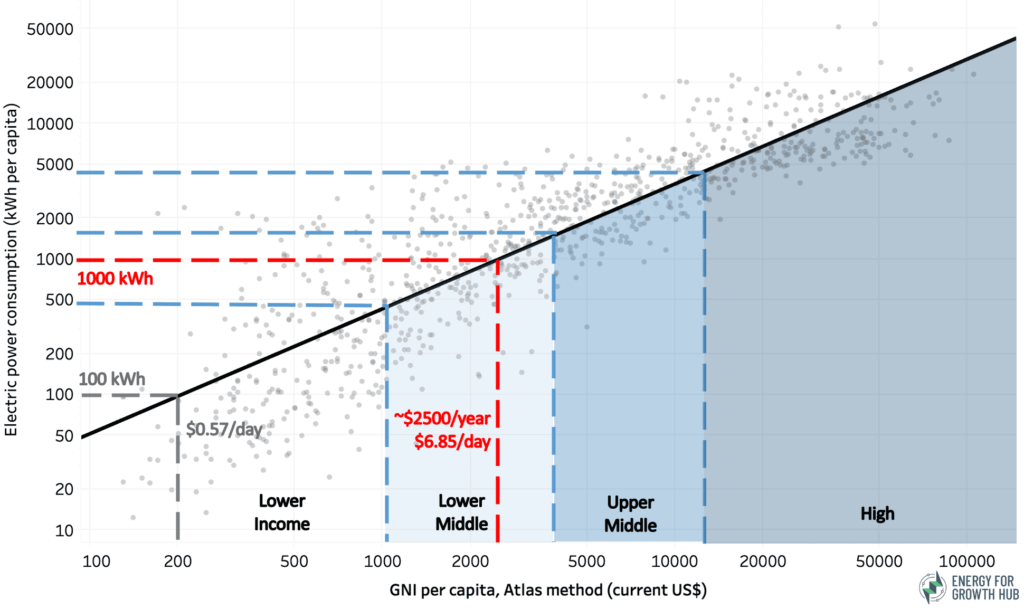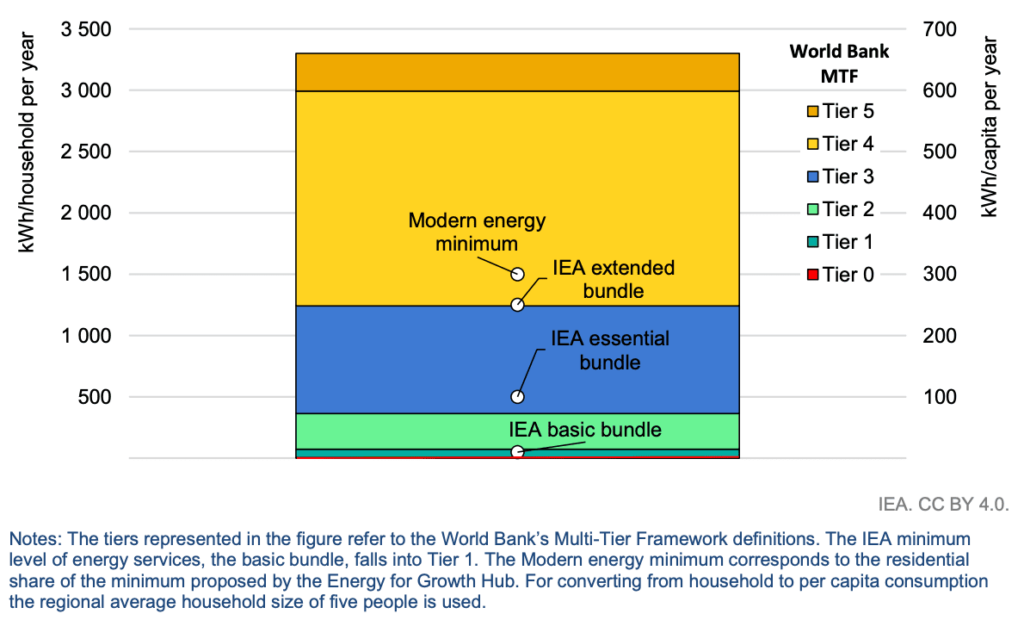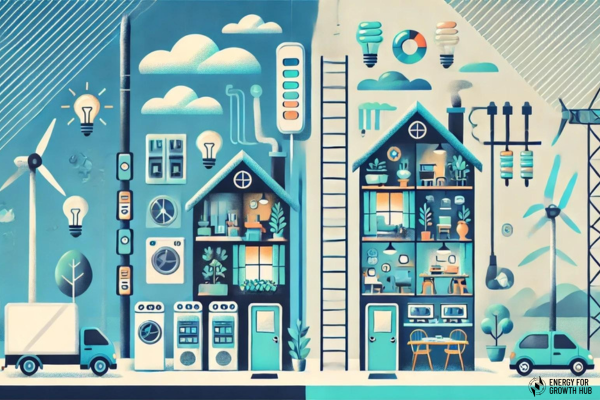Note: Since publication, we have revised the thresholds to 250 kWh residential use and 750 kWh in the wider economy.
The world has pledged to deliver “modern energy” to every person on the planet by 2030. Sounds great, right? But what exactly counts as modern energy access?
The UN’s SDG7: By 2030, “ensure universal access to affordable, reliable and modern energy services.”
The current bar for electricity is set pretty low, just 50-100 kWh consumed at home per person per year. That’s a critical first step — but it’s only enough power for basic lighting and phone charging. With the Rockefeller Foundation, we have proposed an additional metric: the Modern Energy Minimum (MEM). The MEM does two new and important things: It sets a higher global threshold of 1,000 kWh per person per year so we can continue to track progress as people move up the energy ladder. And it widens coverage to include electricity used outside the home, so we can capture the power being used for economic activity. Specifically, the metric tracks the headcount of people (a) using at least 300 kWh at home and (b) living in a country with an average of at least 700 kWh per capita of non-residential electricity consumption. We designed the MEM to more closely align with other development goals, like ending poverty (SDG1) and creating jobs (SDG8). It is meant to add to — not replace — existing metrics like the energy access rate.
The concept emerged from a 10-year effort, spanning two expert working groups (The Energy Access Targets Working Group and The Modern Energy Minimum Working Group) putting their heads together to improve how the global community defines, measures, and tracks energy progress. While the MEM has been endorsed by development leaders and African energy ministers, it has also generated good questions and faced its fair share of misconceptions. Whether you’re a skeptic or just seeking clarification, we aim to set the record straight by addressing some of the most common areas of confusion.
Myth 1: The MEM is ‘just another metric.’
In fact: The MEM is a movement for greater development ambition.
Ending energy poverty isn’t about checking off a box. It’s a means to a bigger goal of ending global poverty and creating economic opportunity in countries where the lack of reliable electricity is holding back growth. Yet, SDG7 currently only tracks success based on basic access: household connections and very low consumption. Since electricity is needed for far more than lighting and 70 percent of the world’s electricity is used outside the home (in industry, commerce, agriculture, and transportation), it’s fair to say that SDG7 falls short on ambition.
We can debate whether 1,000 kWh is the right threshold, but the spirit behind the Modern Energy Minimum matters more than the specific number. The world needs to aim higher by making energy targets more directly relevant to other economic development goals. This means, yes, power for lights and phones, but also enough for other household appliances and especially enough energy in the wider economy to create decent work. Success isn’t just about hitting a 1,000 kWh target, it’s about integrating greater ambition into global goals that lead to bigger development outcomes.
Myth 2: The MEM is too ambitious for people starting at zero.
In fact: The MEM is not a replacement for basic energy access metrics — it’s the next step.
Let’s be clear: basic energy access is a game-changer for millions of people worldwide. And of course, a person living with no electricity at all cannot be expected to suddenly use 1,000 kWh. Everyone on the planet must absolutely get basic access, even if it starts at just 50 kWh delivered through a small system. But no one should mistake basic access as the end goal. Tracking energy access is the first step, and tracking energy that propels growth is the second.
Think about how we measure income-based poverty. We don’t just track people at the ‘extreme poverty’ threshold of $2.15 per day. We also track $3.85, $6.85, and even $25 per day to provide a better understanding of trends over time and how people are moving up the income ladder (or not). Energy poverty needs a similar, multi-step approach. (As it happens, 1,000 kWh per capita correlates almost exactly with $6.85 per day. See Figure 1.) The MEM is the next step on the energy ladder and recognizes energy needs grow as economies develop.
FIGURE 1: Comparing electricity consumption and income levels

Source: The Energy for Growth Hub. 2021. The Modern Energy Minimum: The case for a new global electricity consumption threshold. Data from the World Bank, World Development Indicators.
Myth 3: The MEM is not ambitious enough.
In fact: The MEM is a milestone, not the end goal.
At the same time, some observers have noted that 1,000 kWh is actually not very much electricity for one person over a whole year. True! The average American uses that much electricity each month. With demand skyrocketing in emerging markets from growing urban populations, expanding need for climate adaptation like air conditioning, and the explosive growth of data centers and electric vehicles, you might reasonably worry that the MEM is selling poor people short. Why not aim higher?
Just as the MEM is not the starting point, it’s also not the end goal. The MEM is intended as an ambitious yet achievable milestone in the medium term. It aims to catalyze progress, investment, and policy attention in energy-poor areas, setting a realistic, intermediate target for both household and productive uses. As people reach and surpass the MEM threshold, energy consumption will continue to grow — indeed it must. The MEM serves as a bridge toward a world where abundant reliable electricity is available to everyone. That could mean 5,000 kWh per person, 10,000 kWh, or maybe even more.
Myth 4: The MEM offers nothing new compared to existing metrics.
In fact: The MEM formalizes a way to track power consumption that drives economic growth.
We created the MEM to fill a specific measurement gap. No energy poverty metrics actively report non-residential consumption and most don’t account for higher levels of residential consumption beyond binary connected vs. unconnected. Yet, global institutions have made progress in identifying higher tiers of household consumption over the last decade. The World Bank’s Multi-Tier Framework (MTF) and the International Energy Agency’s energy service bundles offer alternatives for household consumption. The MEM’s household component (300 kWh) is similar to the IEA’s extended bundle (250 kWh) and the MTF Tier 4 (about 250 kWh). See Figure 2.
But here’s what’s different about the MEM:
- Measurability. A meaningful global metric must be easily and reliably tracked at a massive scale. But the current methodology for the World Bank’s MTF requires detailed surveys that are unlikely to be feasible at scale. (This helps explain why the Bank has only run 17 country-level surveys since 2015 and none since 2019.) The MEM will be fully trackable via a new approach we’re pioneering. Explore the data here.
- Non-residential coverage. The key value add of the MEM is its ability to track both non-residential and residential usage in one metric. Energy poverty does not end with meeting household consumption needs. Economies need enough electricity to operate machinery, support small enterprises, run cold storage, advance agricultural systems, and power vehicles and data centers.
- Relevance in countries that may already have high basic access. The combination of higher residential consumption and non-residential usage fundamentally expands the notion of energy poverty beyond access. A person with minimal power at home is living in energy poverty, even if they live in an energy-rich country (e.g., South Africa, Brazil, Egypt, Indonesia). At the same time, a wealthy person with a generator at home is still suffering from energy poverty if they live in an economy where lack of sufficient reliable power kills jobs and opportunity (e.g., Kenya, Nigeria, Cambodia, Pakistan). Thus, the MEM is a metric relevant to both growth and equity.
FIGURE 2: Comparing minimum consumption levels of energy services definitions.

Source: IEA. 2023. Guidebook for Improved Electricity Access Statistics. International Energy Agency.
Myth 5: The MEM creates competition for limited resources.
In fact: Solving energy poverty isn’t one-size-fits-all.
We’ve occasionally heard concerns that adopting the MEM could hurt developers of small energy systems that cannot deliver the higher power usage needed to reach the new threshold. It is true that solar lanterns or small home systems won’t get families to 300 kWh per capita.
But look at it this way: calling for more investment in high-speed rail networks doesn’t hurt the market for e-bicycles. They are both transportation, but they serve entirely different purposes.
The bigger picture is what should matter most: different energy systems serve different needs, so we’re all working toward the same goal. Off-grid solutions, mini-grids, and utility-scale power plants each play distinct roles in a fully electrified national economy. Off-grid solutions may work best in remote, low-density areas where grid extension is cost-prohibitive. They often rely on pay-as-you-go schemes and micro-loans. Mini-grids may leverage concessional financing to bridge the gap in serving denser populations and specific use cases. Traditional grid-based utilities will remain critical for high-population urban and industrial areas while depending on large-scale public and private investment. What’s more, the lines between grid and offgrid are blurring as newer modular innovations allow scaling and integration as energy needs grow.
It’s not about choosing one energy delivery system over another, it’s spurring investment across the entire energy ladder. We’re stronger as partners, not competitors.
To sum up…
The Modern Energy Minimum isn’t just another metric, it’s a call to action. The world needs to raise our collective ambition and work towards a more equitable future where everyone has abundant reliable electricity. Let’s keep the conversation going.


